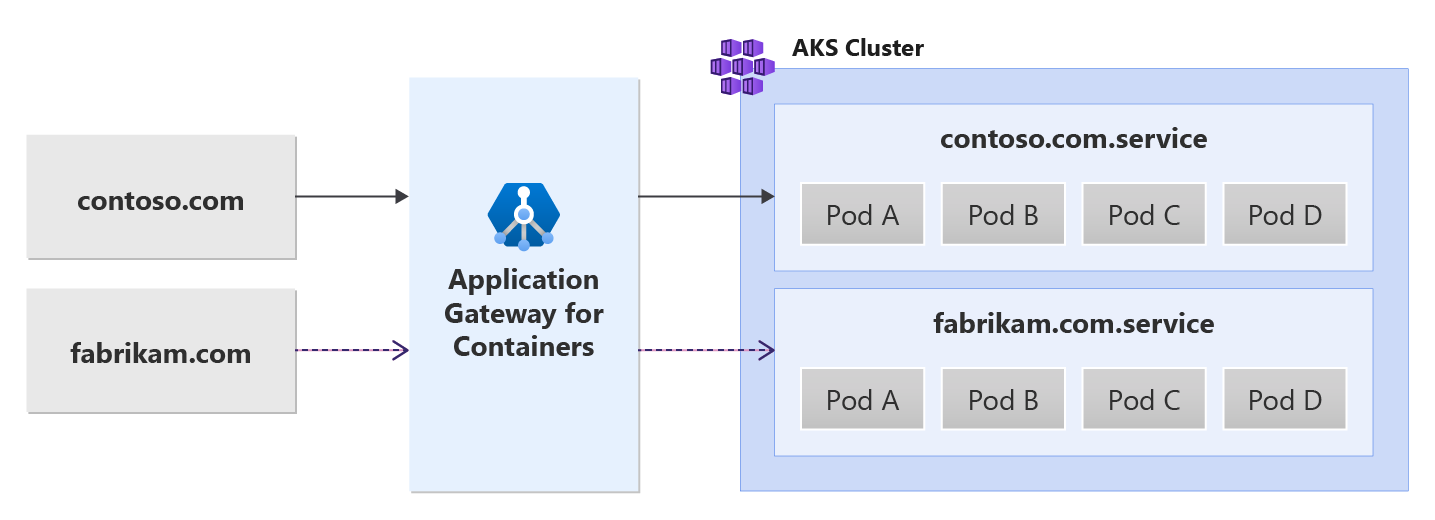具有容器 應用程式閘道 的多網站裝載 - 閘道 API
本文件可協助您設定使用閘道 API 資源的範例應用程式,以示範如何在相同的 Kubernetes 閘道資源/適用於容器的應用程式閘道前端上裝載多個網站。 其中提供下列作業的步驟:
背景
適用於容器的應用程式閘道可讓您在相同的連接埠上設定多個 Web 應用程式,以啟用多網站裝載。 您可以使用唯一後端服務來裝載兩個以上 (含) 的唯一網站。 請查看下列範例情節:

必要條件
如果您使用 BYO 部署策略,請確定您已為容器資源和 ALB 控制器設定 應用程式閘道。
如果您使用 ALB 受控部署策略,請確定透過 ApplicationLoadBalancer 自定義資源布建 ALB 控制器和容器資源的 應用程式閘道。
部署範例 HTTP 應用程式:
在您的叢集上套用下列 deployment.yaml 檔案,以建立範例 Web 應用程式來示範路徑、查詢和標頭型路由。kubectl apply -f https://raw.githubusercontent.com/MicrosoftDocs/azure-docs/refs/heads/main/articles/application-gateway/for-containers/examples/traffic-split-scenario/deployment.yaml此指令會在您的叢集上建立下列物件:
- 名為的命名空間
test-infra - 在命名空間中呼叫
backend-v1和backend-v2的test-infra兩個服務 - 在命名空間中呼叫
backend-v1和backend-v2的test-infra兩個部署
- 名為的命名空間
部署必要的閘道 API 資源
- 建立閘道
kubectl apply -f - <<EOF
apiVersion: gateway.networking.k8s.io/v1
kind: Gateway
metadata:
name: gateway-01
namespace: test-infra
annotations:
alb.networking.azure.io/alb-namespace: alb-test-infra
alb.networking.azure.io/alb-name: alb-test
spec:
gatewayClassName: azure-alb-external
listeners:
- name: http-listener
port: 80
protocol: HTTP
allowedRoutes:
namespaces:
from: Same
EOF
注意
當 ALB 控制器在 ARM 中建立適用於容器的應用程式閘道資源時,ALB 控制器會針對前端資源使用下列命名慣例:fe-<8 個隨機產生的字元>
如果您要變更在 Azure 中建立的前端名稱,請考慮遵循自備部署策略。
建立閘道資源之後,請確定狀態有效,接聽程式的狀態為 [已程式化],並且已經將位址指派給閘道。
kubectl get gateway gateway-01 -n test-infra -o yaml
成功建立閘道後輸出內容的範例。
status:
addresses:
- type: Hostname
value: xxxx.yyyy.alb.azure.com
conditions:
- lastTransitionTime: "2023-06-19T21:04:55Z"
message: Valid Gateway
observedGeneration: 1
reason: Accepted
status: "True"
type: Accepted
- lastTransitionTime: "2023-06-19T21:04:55Z"
message: Application Gateway For Containers resource has been successfully updated.
observedGeneration: 1
reason: Programmed
status: "True"
type: Programmed
listeners:
- attachedRoutes: 0
conditions:
- lastTransitionTime: "2023-06-19T21:04:55Z"
message: ""
observedGeneration: 1
reason: ResolvedRefs
status: "True"
type: ResolvedRefs
- lastTransitionTime: "2023-06-19T21:04:55Z"
message: Listener is accepted
observedGeneration: 1
reason: Accepted
status: "True"
type: Accepted
- lastTransitionTime: "2023-06-19T21:04:55Z"
message: Application Gateway For Containers resource has been successfully updated.
observedGeneration: 1
reason: Programmed
status: "True"
type: Programmed
name: https-listener
supportedKinds:
- group: gateway.networking.k8s.io
kind: HTTPRoute
建立閘道之後,請為 contoso.com 和 fabrikam.com 網域名稱建立兩個 HTTPRoute 資源。 每個網域都會將流量轉送至不同的後端服務。
kubectl apply -f - <<EOF
apiVersion: gateway.networking.k8s.io/v1
kind: HTTPRoute
metadata:
name: contoso-route
namespace: test-infra
spec:
parentRefs:
- name: gateway-01
hostnames:
- "contoso.com"
rules:
- backendRefs:
- name: backend-v1
port: 8080
---
apiVersion: gateway.networking.k8s.io/v1
kind: HTTPRoute
metadata:
name: fabrikam-route
namespace: test-infra
spec:
parentRefs:
- name: gateway-01
hostnames:
- "fabrikam.com"
rules:
- backendRefs:
- name: backend-v2
port: 8080
EOF
建立 HTTPRoute 資源後,請確定 HTTPRoute 資源顯示 [已接受],且適用於容器的應用程式閘道資源的狀態為 [已程式化]。
kubectl get httproute contoso-route -n test-infra -o yaml
kubectl get httproute fabrikam-route -n test-infra -o yaml
確認在每一個 HTTPRoute 中,適用於容器的應用程式閘道資源狀態已成功更新。
status:
parents:
- conditions:
- lastTransitionTime: "2023-06-19T22:18:23Z"
message: ""
observedGeneration: 1
reason: ResolvedRefs
status: "True"
type: ResolvedRefs
- lastTransitionTime: "2023-06-19T22:18:23Z"
message: Route is Accepted
observedGeneration: 1
reason: Accepted
status: "True"
type: Accepted
- lastTransitionTime: "2023-06-19T22:18:23Z"
message: Application Gateway For Containers resource has been successfully updated.
observedGeneration: 1
reason: Programmed
status: "True"
type: Programmed
controllerName: alb.networking.azure.io/alb-controller
parentRef:
group: gateway.networking.k8s.io
kind: Gateway
name: gateway-01
namespace: test-infra
測試應用程式的存取權
現在我們已準備好將一些流量透過指派給前端的 FQDN 傳送至範例應用程式。 使用下列命令來取得 FQDN。
fqdn=$(kubectl get gateway gateway-01 -n test-infra -o jsonpath='{.status.addresses[0].value}')
如果使用 curl 命令 contoso.com 指定伺服器名稱指標,則對於前端 FQDN,會傳回來自 backend-v1 服務的回應。
fqdnIp=$(dig +short $fqdn)
curl -k --resolve contoso.com:80:$fqdnIp http://contoso.com
透過回應,我們應該會看到:
{
"path": "/",
"host": "contoso.com",
"method": "GET",
"proto": "HTTP/1.1",
"headers": {
"Accept": [
"*/*"
],
"User-Agent": [
"curl/7.81.0"
],
"X-Forwarded-For": [
"xxx.xxx.xxx.xxx"
],
"X-Forwarded-Proto": [
"http"
],
"X-Request-Id": [
"dcd4bcad-ea43-4fb6-948e-a906380dcd6d"
]
},
"namespace": "test-infra",
"ingress": "",
"service": "",
"pod": "backend-v1-5b8fd96959-f59mm"
}
如果使用 curl 命令 fabrikam.com 指定伺服器名稱指標,則對於前端 FQDN,會傳回來自 backend-v1 服務的回應。
fqdnIp=$(dig +short $fqdn)
curl -k --resolve fabrikam.com:80:$fqdnIp http://fabrikam.com
透過回應,我們應該會看到:
{
"path": "/",
"host": "fabrikam.com",
"method": "GET",
"proto": "HTTP/1.1",
"headers": {
"Accept": [
"*/*"
],
"User-Agent": [
"curl/7.81.0"
],
"X-Forwarded-For": [
"xxx.xxx.xxx.xxx"
],
"X-Forwarded-Proto": [
"http"
],
"X-Request-Id": [
"adae8cc1-8030-4d95-9e05-237dd4e3941b"
]
},
"namespace": "test-infra",
"ingress": "",
"service": "",
"pod": "backend-v2-594bd59865-ppv9w"
}
恭喜,您已在適用於容器的應用程式閘道上透過不同的主機名稱和閘道 API,安裝 ALB 控制器、部署後端應用程式,並且將流量路由傳送至兩個不同的後端服務。